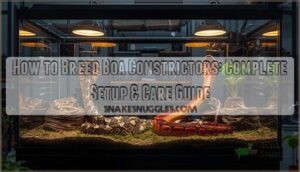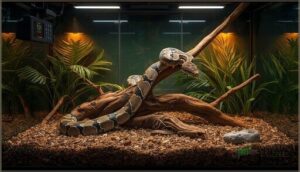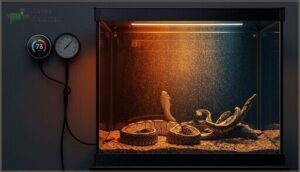This site is supported by our readers. We may earn a commission, at no cost to you, if you purchase through links.

Most people picture boa constrictors as solitary, low-maintenance pets, but breeding them successfully requires months of careful preparation and a deep understanding of their reproductive biology. You can’t just pair two healthy adults and hope for the best—timing, genetics, environmental triggers, and precise husbandry all play critical roles in producing viable offspring.
Getting the temperature gradients wrong or rushing immature animals into breeding can derail an entire season, while proper cycling and conditioning can yield strong, healthy neonates.
Whether you’re working with classic Colombian boas or chasing specific morphs like Fire or Aztec lines, mastering the fundamentals of boa constrictor breeding transforms you from a keeper into a true reptile breeder.
Table Of Contents
- Key Takeaways
- Breeding Requirements for Boa Constrictors
- Setting Up The Breeding Environment
- Pairing and Mating Behaviors
- Gestation, Birth, and Neonatal Care
- Genetics and Responsible Breeding Practices
- Frequently Asked Questions (FAQs)
- What are the mating rituals of the boa constrictor?
- How many babies do boas have at once?
- What time of year do boa constrictors breed?
- Do boa constrictors mate?
- When do boa constrictors breed?
- What is a boa constrictor?
- How do young boa constrictors develop?
- How do boa constrictors breed?
- How many babies do boas usually have?
- Is it hard to breed boas?
- Conclusion
Key Takeaways
- Successful boa breeding demands precise environmental triggers—temperature cycling between 75-88°F, controlled humidity at 55-75%, and photoperiod shifts—because rushing immature snakes or getting these gradients wrong will derail an entire breeding season.
- Males need 18+ months and 4 feet minimum while females require 3-4 years and over 5 feet with solid body weight, because breeding immature animals leads to failed pairings, health complications, and significantly lower success rates.
- Understanding genetics isn’t optional—you need to grasp recessive, dominant, and incomplete dominant inheritance patterns to avoid inbreeding depression, predict morph outcomes, and produce healthy offspring instead of animals with defects or compromised vitality.
- The gestation timeline runs approximately 105 days after the post-ovulatory shed, requiring stable ambient temperatures of 80-85°F and 50-70% humidity throughout, because environmental fluctuations during this critical period directly impact embryo development and neonatal health.
Breeding Requirements for Boa Constrictors
Before you put your boas together, you need to make sure they’re actually ready to breed. Rushing this process can lead to failed pairings, health problems, or even losing your female.
Let’s walk through the three key factors that determine whether your snakes are breeding-ready.
Age and Size Guidelines for Males and Females
Successful boa constrictor breeding starts with proper maturity signs and size requirements. Males should reach at least 18 months old and 4 feet long, though waiting until 3-4 years ensures better results. Females need more time—aim for 3-4 years old, exceeding 5 feet in length, with solid body weight.
Age factors and growth rates directly impact breeding readiness, so patience pays off during husbandry before attempting reproduction. Understanding the ideal breeding age guidelines is vital for a successful breeding program.
Health and Body Condition Assessment
Once your boas hit the right age and size, it’s time to check their body condition. Look for firm muscle tone, clear eyes, and smooth scales—wrinkling or fat rolls spell trouble. Nutrition status matters, so avoid overfeeding. Regular physical monitoring helps catch issues early.
Disease prevention in boa constrictor care means clean enclosures and smart husbandry—your best tools for reptile health. Proper boa care requires understanding reptile health guidelines to guarantee a long and healthy life.
Sexing Methods for Breeder Selection
Once you’re sure your boas are healthy, it’s time to nail down sex determination. Probing techniques are your benchmark, especially for adults, while palpation works well for younger snakes.
Visual inspection and morphological analysis—like checking tail length and spurs—help, but aren’t foolproof. Genetic testing isn’t mainstream yet, so hands-on sexing remains key for responsible breeding and husbandry.
Setting Up The Breeding Environment
Getting your boas ready to breed starts with the right setup. The enclosure, temperature, humidity, and lighting all play a part.
Here’s what you’ll need to get your breeding environment just right.
Ideal Enclosure Size and Substrate
Ever tried fitting a giant puzzle together, only the pieces are living, breathing snakes? Your enclosure setup is critical for snake husbandry and breeding success. Here’s your must-haves:
- Spacious Enclosure Design
- Sturdy Climbing Structures
- Deep, absorbent Substrate Options
- Humidity Control with bioactive blends
- Smart Temperature Gradients
Get these right—your Boa constrictor will thrive!
Temperature and Humidity Adjustments
With breeding boas, your biggest allies are Thermal Gradients and Humidity Control. Temperature Cycling kicks off follicle development—think 75°F lows and 88°F hotspots, monitored daily. Humidity should hover between 55–75%, but bump up to 70% for shedding.
Environmental Monitoring tools like digital thermostats and hygrometers make Heat Management and Incubation precise, keeping your Boa Constrictor healthy and responsive.
Lighting and Seasonal Cycling Techniques
Beyond Temperature Control, smart Lighting and Photoperiod Cycles trigger your boas’ breeding instincts. UVB Lighting at a 2.0–3.0 UVI mimics natural basking, while Seasonal Shifts—11-hour days in winter, 13-hour days in summer—sync with reproductive rhythms.
- Combine UVB with Temperature Cycling (75°F nights, 88°F days) for ideal follicle development
- Light Therapy improves coloration and breeding responsiveness through Environmental Cycling
- Adjust Humidity Levels alongside photoperiod changes to replicate natural seasonal conditions
Pairing and Mating Behaviors
Once your breeding environment is dialed in, it’s time to bring your male and female together.
This stage involves understanding how boas naturally interact during breeding season, from their initial introduction to the telltale signs that mating has actually occurred.
Let’s walk through what you need to watch for and how to manage the pairing process for the best results.
Introducing Breeding Pairs Safely
Timing your introductions right makes all the difference—place the male into the female’s enclosure one week after her last meal, ideally from late October through March when ambient temperatures drop to 75-82°F. This window aligns with natural breeding receptiveness and reduces stress-related aggression.
| Introduction Protocol | Temperature Range | Timing Guideline |
|---|---|---|
| Gradual male placement | 75-82°F ambient | 1 week post-feeding |
| Intermittent separation | 88-90°F hotspot | 2-3 day observation |
| Pheromone conservation | Maintain humidity | 3-week reintroduction if needed |
Monitor courting behavior within those first few days—tongue flicking and body wrestling signal receptiveness. If nothing happens, remove him and try again after three weeks. Avoid overhandling during this sensitive period to prevent defensive responses that derail pair bonding and snake acclimation.
Courtship, Competition, and Visual Locks
When you spot the male crawling over the female with intense tongue flicking, that’s male courtship in action—he’s reading her reproductive cues. Visual locks happen when he coils along her back for hours, rubbing his spurs to stimulate female receptivity and align their cloacas.
If you’re pairing multiple males, expect wrestling matches as they compete for mating position during these critical courting behaviors.
Recognizing Successful Copulation
Look for the male’s hemipenis insertion into her cloaca—that’s the confirmation of successful copulation you’re after. During this lock, you’ll notice the female remains unusually still while both snakes maintain tail contact for several hours.
Key mating behaviors and breeding cues include:
- Male spur scratching along her sides and cloaca to trigger receptivity before fertilization
- Extended courtship rituals lasting 3-8 hours with continuous tongue flicking
- Post-copulation passivity where she shows reduced activity signaling gestation period onset
- Mid-body thickening appearing 2-3 weeks before ovulation, confirming breeding success
Gestation, Birth, and Neonatal Care
Once your female ovulates, the waiting game begins—and knowing what to expect makes all the difference between stress and confidence. The gestation period follows a predictable timeline, but you’ll need to watch for specific signs and adjust her environment to support a healthy birth.
Let’s walk through how to recognize pregnancy, what conditions she needs during those critical months, and how to care for your neonates once they arrive.
Signs of Ovulation and Pregnancy
Understanding reproductive health and fertility indicators in breeding female boa constrictors begins with recognizing the signs of ovulation. A distinctive midbody swelling, resembling a football-shaped bulge, appears for a few days during ovulation. This temporary change is a key indicator of the reproductive cycle.
| Ovulation Signs | Pregnancy Care Indicators |
|---|---|
| Temporary midbody swelling (2-3 days) | Persistent increased girth |
| Post-ovulatory shed (16-20 days after) | Darkened coloration, especially belly |
| Meal refusal begins | Seeks warmest enclosure spots |
After the post-ovulation shed, gestation monitoring becomes more straightforward, marking the start of the gravidity timeline. Behavioral changes such as reduced activity, belly-side positioning, and appetite fluctuations signal successful breeding. These observations are crucial for ensuring the health and well-being of both the breeding female and her offspring.
Gestation Timeline and Environmental Needs
Once the post-ovulatory shed occurs, you’re looking at approximately 105 days until birth—that’s your gestation period. During this incubation period, environmental control becomes critical for embryo development.
Keep ambient temperature around 80-85°F with basking spots at 90°F, avoiding temperature fluctuations. Humidity management stays between 50-70% throughout gestation. These stable conditions create the ideal incubation environment your gravid female needs.
Preparing for Birth and Neonate Care
As birth nears, you’ll notice your female passing a waxy, yellowish stool and becoming restless—classic signs that labor’s imminent.
Prepare for what’s ahead:
- Set up a lukewarm water bath for your female’s postpartum recovery
- Ready humid plastic tubs at 88-90°F for newborn reptile care
- Stock frozen-thawed fuzzy mice for first feedings
Humidity control at 80% ensures healthy neonatal boa constrictor care, while maternal recovery demands gentle handling and gradual postpartum feeding.
Genetics and Responsible Breeding Practices
Breeding boas isn’t just about pairing any two snakes and hoping for the best. You need to understand how genetics work, choose your breeding animals carefully, and avoid mistakes that can hurt your reputation or produce animals with health issues.
Let’s break down what you need to know to breed responsibly and produce healthy, quality boas.
Understanding Boa Constrictor Genetics
Genetic diversity isn’t just breeder jargon—it’s your roadmap to healthy offspring and predictable results. Boa constrictor genetics involve recessive, dominant, and incomplete dominant genes that control morph identification and color patterns.
Understanding heterozygous and homozygous traits helps you predict outcomes before pairing. Gene expression can surprise you if you’re not tracking heredity patterns carefully.
Species classification matters too, since imperator and constrictor genetics don’t always play nicely together.
Selecting Breeder Morphs and Traits
Now you’re ready to choose your breeding stock. Fire, Aztec, and Motley boas make excellent starting morphs thanks to their striking color patterns and predictable trait inheritance. Hypo morphs intensify saturation beautifully, while Karl Albino remains the benchmark for recessive breeding.
You’ll want females around 5-7 feet with muscular, square bodies—not overweight ones that struggle with fertility. Match them with slightly smaller males for best breeding outcomes.
Genetic diversity matters here; mixing locality-specific traits like Nicaraguan T-positive boas can strengthen your line while maintaining morph identification clarity.
Avoiding Common Breeding Pitfalls
Breeding mistakes often stem from rushing immature animals—females under 3 years or males below 4 feet rarely succeed. Environmental factors like poor humidity (below 75%) and incorrect temperature cycling disrupt hormonal triggers, causing reproductive challenges.
Watch for health risks including respiratory infections during gestation, which lead to miscarriages.
Inbreeding depression creates genetic issues: smaller litters, higher mortality, and morph-related defects that responsible reptile breeding should always avoid.
Inbreeding depression causes smaller litters, higher mortality, and genetic defects that responsible breeders must avoid
Frequently Asked Questions (FAQs)
What are the mating rituals of the boa constrictor?
When nature calls the shots, mating rituals unfold with precision. Male Courtship in Boa Constrictors relies on Pheromone Signals—males detect Female Receptivity through chemical cues, triggering Courting Behavior that includes rubbing, spur scratching, and competitive Pairing dynamics.
How many babies do boas have at once?
Litter size usually ranges from 10 to 65 neonates, averaging around 25 live young. Larger, healthier females in prime condition produce bigger litters.
Factors like nutrition and stress greatly impact reproductive success and birth frequency.
What time of year do boa constrictors breed?
Think of nature’s rhythms like a conductor’s baton—boa constrictors breed during dry months, usually April through August.
Captive breeding techniques often use temperature fluctuations and humidity levels from October to March, with geographic variations influencing timing.
Do boa constrictors mate?
Yes, boa constrictors mate through internal fertilization. Males use their pelvic spurs during courtship rituals to stimulate females, entwining their bodies to align cloacas for successful copulation and reproduction.
When do boa constrictors breed?
The clock on breeding season starts ticking when cooler, drier months arrive—usually April through August in their range.
Your boa’s reproductive timing follows seasonal temperature drops and light shifts, triggering mating cycles naturally.
What is a boa constrictor?
Boa constrictors are large, non-venomous Boid Species native to Central and South America. They’re heavy-bodied reptiles ranging 8-13 feet, thriving across diverse Habitat Types from rainforests to savannas with distinctive hourglass markings.
How do young boa constrictors develop?
From birth, young snakes emerge fully formed and ready to thrive independently. Neonate growth accelerates through weekly feeding strategies, while juvenile development brings morphological changes and environmental adaptation as hatchlings master their surroundings.
How do boa constrictors breed?
Unlike pythons that lay eggs, these live-bearing snakes follow ovoviviparous reproduction—females develop eggs internally, then birth fully-formed neonates after a 5–8 month gestation following successful mating rituals and courtship behaviors.
How many babies do boas usually have?
You can expect around 25 neonates per litter on average, though litter size factors like your female’s health and body condition can push that range anywhere from 10 to 65 babies.
Is it hard to breed boas?
Reptile breeding presents real challenges—only about 50% of pairings succeed, and females need five years to mature.
However, with proper boa health, habitat design, and understanding of breeding habits, you’ll achieve breeding success consistently.
Conclusion
Picture that moment when healthy neonates curl around your fingers after months of careful preparation—that’s the payoff for mastering boa constrictor breeding. You’ve learned the environmental triggers, genetic considerations, and precise timing that separate successful breeders from hopeful hobbyists.
Now it’s about consistent execution: proper cycling, patient observation, and responsible pairings. Each season sharpens your skills, building toward stronger bloodlines and healthier offspring. Your journey from keeper to breeder starts with applying these fundamentals deliberately and confidently.
- https://animaldiversity.org/accounts/Boa_constrictor/
- https://reptilesmagazine.com/tips-for-breeding-boa-constrictors/
- https://animals.howstuffworks.com/snakes/boa-constrictor.htm
- https://community.morphmarket.com/t/bci-breeding-tips-schedule-advice/44135
- https://www.emilygweigelphd.com/wp-content/uploads/Zoo-Biology-2018-Hill-Growth-rates-of-juvenile-Boa-constrictor-under-two-feeding-regimes.pdf












